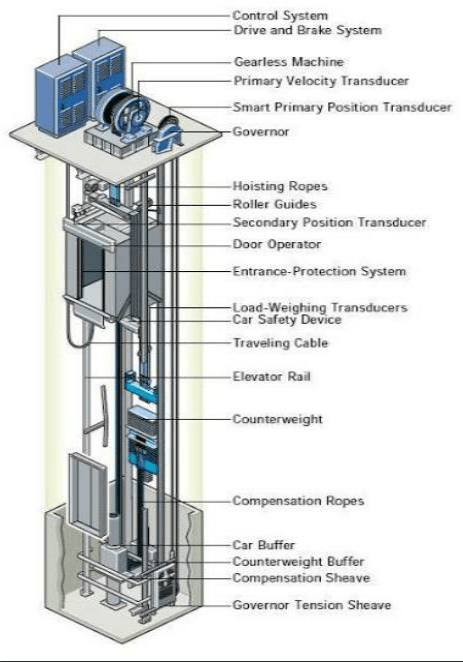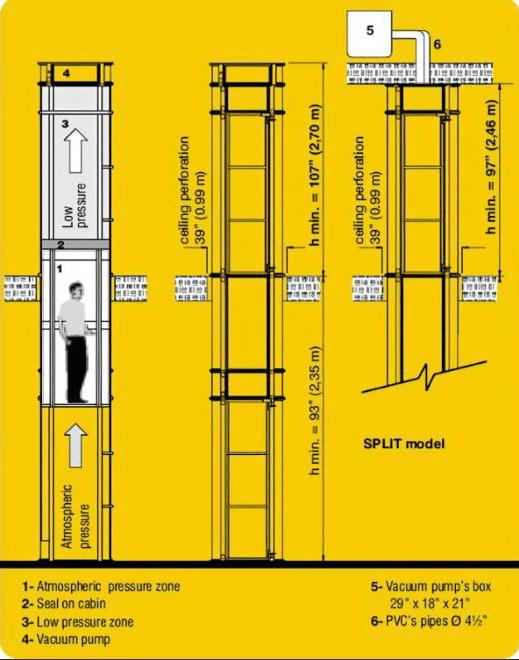Table of Contents
ToggleDefine Elevator
An Elevator is a vertical transport system that carries people or goods between the floors of building safely and efficiently.
In an elevator, car is raised or lowered within several floors of a commercial and residential building. Depending on the load and the area of application, these elevators are installed with rated capacity. Hydraulic elevators are simple and effective in which the force required to move the car is low compared to the other elevators, but still their use is limited for certain stories high buildings such as 4 to 5 owing to the working ability of these elevators.
Compared to traditional elevators, pneumatic-vacuum elevators are environmentally friendly, easy to maintain, install and operate. And, compared to hydraulic elevators, pneumatic vacuum elevators require high pressure to move the car- and, in addition, their usage too is limited for a limited number of storied buildings. These elevators that run based on-air pressure are safe and popular over the past several years for two to three-storied buildings.
Nowadays buildings are constructed to greater heights and with the invention of traction electric elevators – they are commonly used in such buildings. Top speed, smooth ride quality and better elevation are the basic characteristics of these elevators.
Types of elevator
Cable driven or traction Elevators
Hydraulic Elevators
Pneumatic Elevators
Cable driven or traction Elevator

This is a typical and most popular type of elevator consisting of a few numbers of hoisting ropes or steel cables which run over a pulley connected to an electric motor. This elevator can be a geared or gearless-traction elevator. In this type of elevator, five to eight wire cables or hoisting cables are attached to the top of the elevator car by wrapping around it on sheaves at one end, and the other end is attached to a counter weight that moves up and down on its guiderails. This counter weight is equal to the weight of the car plus half of the maximum passenger load in that car. This means, during the lifting operation, it needs power for the extra passengers in the car, and, the rest of the weight is balanced by the counter weight.
Whenever the control system attached to the elevator drives the motor in the forward direction, the sheaves also turn around causing to move the car elevator upwards, and then stopping in the desired floor wherein the car is balanced by the counter weight. For the downward movement of the car, reverse happens through a rotating motor via a control mechanism. Some of the elevators use motors with four-quadrant operation to save the energy in regenerative mode. Due to high speeds and high-rise capabilities, these types of elevators are found in many of the applications of lifts and escalators.
Hydraulic Elevator
The below figure shows the working of a hydraulic elevator wherein hydraulic fluid with a pumping system moves the elevator car up and down. In this type of elevator, a tank or fluid reservoir supplies hydraulic oil and the pump forces this oil through a least resistance path and returns it to the reservoir when the valve is opened. So, when the valve is closed, the pressurized oil created by the pump pushes the piston upside so that the car moves in the upward direction. And when the valve is opened, the fluid returns back to the tank, and hence the piston moves downwards.
If the elevator reaches the correct floor, the elevator-control system sends the signals to a motor driver, which stops the motor, and then the pumping of fluid is halted at that position. While lowering, the car stays on exact floor by controlling the signals to the valve mechanism to open or close the valve. This is how the hydraulic system is operated for lifting and lowering the elevator car.
Due to a special type of fluid in this system, the force required to push the piston is very less. This is an advantage of it, but in order to elevate the car, the piston length required should be more. In other words, if the building height is more, the piston length required should also be longer. This requires an in-depth buried structure for high-storied buildings that’s why these are limited for high-storied buildings.

Pneumatic elevator
This type of elevator consists of exterior cylinder which is transparent self-supporting tube consisting of modular sections, which can be easily fitted into one another. The roof of this tube is made up of steel that ensures air-tight closures with suction inlets and valves. An elevator car runs inside this cylinder, and the head unit on the top cylinder contains turbines, valves and controllers to control the movements of this elevator.
The vacuum pump of the elevator generates higher and lower atmospheric pressures above or below the elevator car, which cause to move the elevator upwards and downwards. As shown in the below figure, the car is lifted high by a higher atmospheric pressure below the car and a lowered air pressure above the car.
When the valves in the low-pressure chamber allow air into it – this causes to lower the car. These valves are also involved in controlling the speed of the car in a desired level. But, this type of elevator cannot build enough pressure to push the car to more than 3- 4 storied high building. That’s why these elevators find limited usage.


“Great read! I’ve always been curious about how smart grids work — this explained it so clearly.”
Thanks for appreciation.
Please share our website in your friends group and follow our social group.
This is really breaks down elevator types in a way anyone can get! I never knew traction, hydraulic, and pneumatic elevators were so different from each other. I found it super cool to learn about counterweights in traction elevators and how they save energy. The writer did a great job explaining technical stuff in a way that non engineers like me can easily follow.
Thanks for appreciation.
For more electrical Knowledge, Please follow my Insta/Telegram/Whatsapp group.
Now, my focus on spread my website content to more readers.
To boost my moral, Please share my website to your friends.